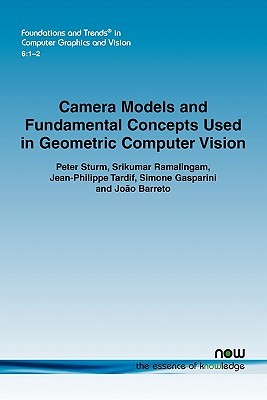
- We will send in 10–14 business days.
- Author: Peter Sturm
- Publisher: Now Publishers
- Year: 2011
- Pages: 196
- ISBN-10: 1601984103
- ISBN-13: 9781601984104
- Format: 15.6 x 23.4 x 1.3 cm, minkšti viršeliai
- Language: English
- SAVE -10% with code: EXTRA
Camera Models and Fundamental Concepts Used in Geometric Computer Vision (e-book) (used book) | bookbook.eu
Reviews
Description
Camera Models and Fundamental Concepts Used in Geometric Computer Vision is mainly motivated by the increased availability and use of panoramic image acquisition devices, in computer vision and several of its applications. Different technologies and different computational models thereof exist and algorithms and theoretical studies for geometric computer vision (structure-from-motion) are often re-developed without highlighting common underlying principles. Camera Models and Fundamental Concepts Used in Geometric Computer Vision surveys the image acquisition methods used in computer vision and especially, the vast number of camera models that have been proposed and investigated over the years, and points out similarities between different models. Results on epipolar and multi-view geometry for different camera models are reviewed as well as various calibration and self-calibration approaches, with an emphasis on non-perspective cameras. Camera Models and Fundamental Concepts Used in Geometric Computer Vision also describes what the authors consider are fundamental building blocks for geometric computer vision or structure-from-motion: epipolar geometry, pose and motion estimation, 3D scene modeling, and bundle adjustment. The main goal here is to highlight the core principles of these, which are independent of specific camera models.
EXTRA 10 % discount with code: EXTRA
The promotion ends in 23d.14:24:25
The discount code is valid when purchasing from 10 €. Discounts do not stack.
- Author: Peter Sturm
- Publisher: Now Publishers
- Year: 2011
- Pages: 196
- ISBN-10: 1601984103
- ISBN-13: 9781601984104
- Format: 15.6 x 23.4 x 1.3 cm, minkšti viršeliai
- Language: English English
Camera Models and Fundamental Concepts Used in Geometric Computer Vision is mainly motivated by the increased availability and use of panoramic image acquisition devices, in computer vision and several of its applications. Different technologies and different computational models thereof exist and algorithms and theoretical studies for geometric computer vision (structure-from-motion) are often re-developed without highlighting common underlying principles. Camera Models and Fundamental Concepts Used in Geometric Computer Vision surveys the image acquisition methods used in computer vision and especially, the vast number of camera models that have been proposed and investigated over the years, and points out similarities between different models. Results on epipolar and multi-view geometry for different camera models are reviewed as well as various calibration and self-calibration approaches, with an emphasis on non-perspective cameras. Camera Models and Fundamental Concepts Used in Geometric Computer Vision also describes what the authors consider are fundamental building blocks for geometric computer vision or structure-from-motion: epipolar geometry, pose and motion estimation, 3D scene modeling, and bundle adjustment. The main goal here is to highlight the core principles of these, which are independent of specific camera models.


Reviews